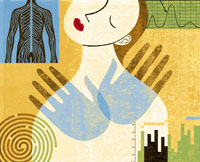Back to: News & Events : Past Meetings and Workshops : Conference on the Biology of Manual Therapies : Agenda

Natcher Conference Center
National Institutes of Health
June 9-10, 2005
Functional Neuroimaging Techniques in Manual Therapy Research: Current Status and Future Directions
Norman W. Kettner, D.C., Chair, Department of Radiology, Logan College of Chiropractic, Chesterfield, Missouri
Manual therapy research has made little use of modern multi-planar (3D) imaging techniques. One barrier to their use has been the problem of motion artifacts. There are imaging designs however, which may circumvent these and other technical constraints. Imaging of the clinical response rather than the technique, for example. In this design, interventions are done outside of the scanner with baseline and follow up imaging providing the opportunity to monitor results. Examples of these imaging techniques include structural magnetic resonance imaging (MRI) and its more recent advance, functional, or fMRI. Magnetoencephalography (MEG) and positron emission tomography (PET) are techniques also capable of catalyzing the progress of manual therapy research by virtue of their unique imaging capabilities particularly in the brain. The relatively high spatial and temporal resolution of these in vivo imaging techniques provides a structural (anatomical) display, which is co-registered in 3D space with functional (physiological i.e. synaptic activity, vascular perfusion) information. Such techniques offer the possibility of exciting new advances especially in the exploration of interactions of manual therapy with the central nervous system (CNS). Sensory, cognitive, and motor functions are displayed in response to a controlled series of stimuli in normal and disordered sample populations. The investigation of manual therapy interactions with clinically important CNS networks such as the pain neuromatrix, attentional or affective allocation in pain perception, or the potential for beneficial neuroplastic and autonomic modulation are a few promising areas for investigation.
This session will briefly highlight the technical principles, assumptions, and constraints of these imaging techniques with respect to exploration of the biological actions of manual therapy. Emphasis will be on the underlying biomechanical and CNS mechanisms. An overview of current work and some proposed areas for research in manual therapy utilizing these techniques is to be presented.
Both manual therapy and another CAM technique from Traditional Chinese Medicine, acupuncture, may share some mechanisms of action with respect to mechanoreceptor signaling and CNS modulation. These parallels will be used as a guide to stimulate future research directions in manual therapy.
